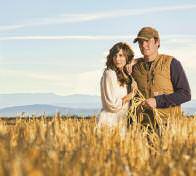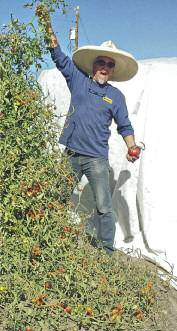edible garden
REAP WHAT YOU SOW
Saving a tradition, one seed at a time.
WRITTEN BY KAY FAHEY
ILLUSTRATIONS BY REED DEWINTER
I will never taste my grandmother’s butterbeans again.
Every summer when I was little, we visited my grandparents’ Mississippi farm. We feasted on biscuits, blackberries, and, best of all, Grandma’s butterbeans. They were subtly sweet little things, pale green and, oh, so tender. Grandma saved the seed from the best bushes year after year, until she had the most delectable butterbean possible.
But after Grandma died, those seeds disappeared, and I learned a bitter lesson about the importance of seed saving.
Farmers traditionally saved seeds to plant the next year. The rise of modern agribusiness nearly put an end to this, but farmers such as Bill Mewaldt of Mewaldt Organics are reviving the practice.
For many seed savers, the motivation is partly economic. University of Nevada, Reno master gardener Carol Ort recommends saving seeds from plants with low germination rates, which require more seeds to produce a sizeable crop, and short-lived plants, such as cilantro, that need planting every few weeks to ensure a steady supply.
Mewaldt points out that by saving your own seeds, over time your plants become better adapted to your conditions. Save seeds from plants that thrive in your microclimate, and the next generation will retain those successful traits. You can even select seeds based on traits you want to encourage. Plant the seeds from your hottest peppers and over time your peppers will raise blisters.
Choose Heirlooms
There are a few things to keep in mind for successful seed saving. Don’t try to save seeds from hybrids; they don’t breed true. Instead, stick to open-pollinated varieties such as heirlooms.
“Go for the easy ones,” Ort recommends.
If you want to ensure that your seeds will produce exactly the same variety as the parents, you need to guard against cross-pollination. This isn’t a concern with self-pollinators such as tomatoes. But many other plants are wind or insect pollinated, which means your neighbor’s pickling cucumber may pollinate your slicing variety. You will get a cucumber, but there’s no telling what kind. One solution is to distance your plants from similar varieties. If you really are concerned, Grant Olson, education coordinator for Seed Savers Exchange, advises enclosing blossoms in a mesh bag.
Harvest Time
It’s important to harvest your seeds when they’re ready. Some seeds, such as parsley and peas, should be harvested when they’re dry and hard. With tomatoes, harvest when the tomato is ready to eat. With squash, you want the vegetable to be a bit over-ripe so seeds are fully mature.
After harvest, seeds that were enclosed, such as melons, should be rinsed and then spread on something such as a coffee filter until dry. As soon as seeds are completely dry, they can be stored in a cool, dark, dry location. An unheated garage is ideal.
“Storage is mostly a warmth problem,” Olson says. “Any temperature over 80 degrees is detrimental.”
With all the advantages of seed saving, there is yet another important reason to do it. By saving seeds, you are maintaining the genetic diversity of our planet — and our culinary heritage.
“Seed saving is the right thing to do,” Mewaldt says.
Every year, food writer and gardener Kay Fahey saves seeds from her Sun Gold tomatoes, French marigolds, Kentucky Wonder green beans, and more.
Extracting Tomato Seeds
There’s debate on whether to ferment tomato seeds. Some people maintain that they must be soaked in water until scum forms. Others change the water every day or so and soak only until the gelatin surrounding the seeds has dissolved. Mewaldt simply spreads his tomato seeds on paper towels and lets them dry. The next season, he plants, paper and all.
“The only benefit to soaking tomato seeds is it makes them easier to handle,” he says.

Resources
For organic seeds to get you started, check out the Seed Savers Exchange rack at Hungry Mother Organics, 3190 Hwy. 395, Minden, Nev. 775-267-3084; www.Hungrymotherorganics.com
Also visit Moana Nursery in Reno (www.Moananursery.com) or Garden Shop Nursery in Reno ( www.Gardenshopnursery.com)
Seed to Seed by Suzanne Ashworth
A Seed Saving Guide from Organic Seed Alliance (online resource)
Master gardeners Liz Morrow and Linda Cavanagh recommend the seed-saving tips from Oregon State University Extension Service at Extension.oregonstate.edu
WRITTEN BY KAY FAHEY
ILLUSTRATIONS BY REED DEWINTER


